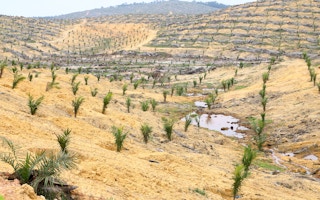If demand for palm oil keeps growing the way it has been in Indonesia’s eastern Kalimantan region, there might not be enough degraded land available in 2020 to prevent further deforestation by the industry, a new study suggests.
A team of researchers from two universities in the Netherlands published their findings on Tuesday in the online journal GCB Bioenergy (open access).
In their research, the team aimed to analyse whether the production of palm oil can be reconciled with the production of other commodities, while limiting the loss of primary forest and local food production. Their research focused on the Indonesian provinces of North and East Kalimantan on the island of Borneo.
Because of logging, forest fires and peatland conversion, the provinces together comprise the third-largest greenhouse gas emitting region in the archipelago.
The authors concluded it would only be possible to accommodate for growth of palm oil and other commodities (pulpwood, rubber and rice) under a low-growth projection, and only if mitigation measures on land sparing —the setting aside of land for biodiversity conservation — land zoning and usage of degraded lands are implemented.
However, the authors find it “questionable” whether low-growth rates are “realistic for this study region,” given, for example, the expected increase of palm oil production for biodiesel, and increasing global demand for natural rubber.
The scientists based their findings on regional data from multiple sources, including Indonesia’s Central Statistics Bureau (BPS) and the World Resources Institute’s Suitability Mapper webtool. The latter was used to define the amount of underutilised and degraded land available in the region to accommodate for future agricultural expansion, which was estimated at 0.7-1 million hectares.
This figure accounts for the estimation that on the ground only 40 percent of the land will actually be available and suitable, based on previous field work.
The area under oil palm cultivation is expected to grow to 1.1-1.8 million hectares in 2020 (from 0.4 million hectares in 2008, BPS), following current and historical growth rates. In 2013, the area under cultivation had already nearly reached 1.1 million hectares.
The findings run counter to the Indonesian Palm Oil Pledge (IPOP), an alliance of palm oil giants which holds that the country’s ambitious 2020 targets for production of the commodity can be reached by expanding into degrading lands and raising yields, rather than via additional forest clearance. In contrast, the researchers make a pledge in their article for “halting the projected linear or even exponential expansion of oil palm and other commodities.”
At the same time they stress the need for increasing yields, using underutilized (degraded) lands, and improving production chain efficiency, to be able to actually prevent further deforestation. In addition, the researchers stress the importance of further field research to support responsible selection of suitable lands for oil palm expansion.
“However, switching to sustainable palm oil production only is not going to be enough,” explained Carina van der Laan, corresponding author of the article. “We also need to bring down global consumption and the local production of palm oil.”
At the same time, Van der Laan, PhD candidate at the Copernicus Institute of Sustainable Development at Utrecht University, warns for a one-sided focus on palm oil as a driver of deforestation. “If you are talking about Riau [province], palm oil is the most important driver.
But in East Kalimantan, we’ve seen a succession of land-use changes happening over the course of several years in the same location. So even if you take away palm oil from the equation, it is still economically valuable to clear the forest for rubber or pulpwood plantations.”
“In the end, we need to keep appreciating the oil palm and fully utilise its potential as a high-productive crop. Deforestation is a complicated problem that needs to be addressed on its own by involving governments, companies, local communities and consumers. The measures we studied, such as improving yields and utilising degraded lands, are a necessary step, but more focus is needed to achieve the necessary results.”
Eco-Business republished this story with permission from Mongabay. It was originally published by Mongabay under Mongabay Reporting Network, licensed under Creative Commons.

















